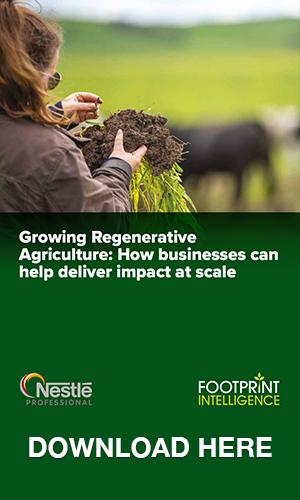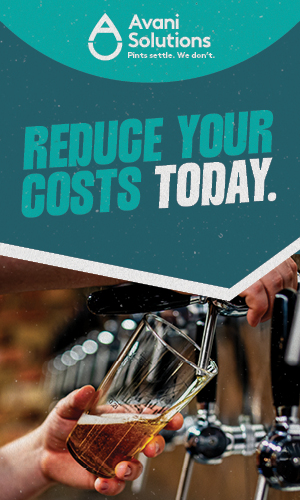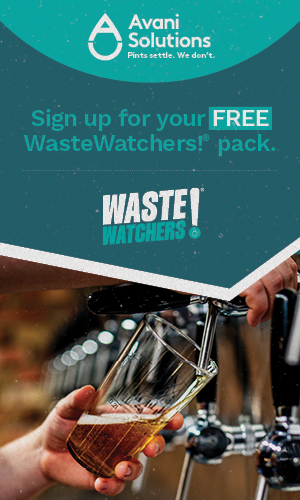Alternative proteins have potential, but they aren’t a free pass to sustainable consumption, according to Aramark head of ESG, Gina Camfield. By David Burrows.
“When you’re serving millions of meals a day, you’re shaping the health of people and the planet, so I think we have a moral obligation to accelerate the shift towards sustainable consumption,” says Gina Camfield.
As head of ESG at Aramark, and with a background in nutrition, Camfield has been following the debates around meat alternatives closely. There is much to applaud in terms of ambition – “higher-end restaurant groups and hotel chains are revisiting their menus, offering plant-based alternatives, and not as a novelty, but as a core part of their offering – yet the rate of progress feels “incremental. Foodservice can and should take bolder steps,” she says.
“Imagine if foodservice companies fully embraced pairing plant proteins with responsibly sourced meat to create hybrid menus that bridge sustainability and tradition,” she explains. “This is where foodservice can push boundaries – by leading with choice, education, and variety that appeals to consumers across the board.”
Stuck on labels
Companies like Aramark, which serves more than 265,000 meals a day in the UK, influence not just what’s on the menu, but consumer behaviour. That doesn’t mean all they need to do is pop a carbon label on meals and hope for the best.
“When we first started looking at things like carbon labels there was definitely a feeling they could be a game-changer,” Camfield explains. “But from what we’ve experienced so far they won’t reduce our emissions significantly. It’s the back of house where this kind of environmental data makes a huge difference at the moment; the information is also invaluable for us being able to target the right areas too.”
Think of a classic British menu and where to cut carbon and the beef pie or the cheeseburger are often starting points. Red meat certainly has a hefty carbon footprint (as does cheese), but if you are not selling many of the pies or cheeseburgers the benefits of change – such as reformulation – in terms of carbon can be limited. Aramark, with the help of Foodprint (powered by Nutritics), is therefore honing in on the dishes that contribute most to its food-based emissions. “If we reduced the emissions from our top 150 dishes by just 10% it would cut our total emissions from dish sales by 4%,” Camfield explains. (Aramark’s total emissions at the last count, in 2021, were just under 200,000tCO2e, down 30% against its baseline; new SBTi-aligned figures are on the way).
One site sells an awful lot of lattes, so the focus is on how to reduce the emissions from the dairy milk, for example, or encourage switches to plant-based options. If only it were as simple as just switching from the ‘real thing’ to alternatives though.
Alternative fight
Plant-based alternatives are currently under scrutiny. Mock meats in particular are being pilloried for their processed nature. A recent analysis by the Food Foundation found the vast majority of plant-based meat alternatives perform better on environmental indicators, with significantly reduced greenhouse gas emissions and water footprints compared to meat. Not surprising. On the question of healthiness, however, the findings were far more nuanced: the nutritional profile of plant-based meat alternatives is not on average notably worse than for meat products, but there are specific issues with certain groups of product.
The attention on alternatives is a “good thing”, according to Camfield, particularly when considering the levels of processing involved in some of the products. “Many highly processed plant-based meats aren’t healthier for consumers, and the environmental benefits aren’t as clear-cut as some would like to believe,” she explains.
Camfield’s experiences tend to mirror the findings of the Food Foundation’s report, which found that less processed alternatives to meat like beans and pulses perform strongly on a number of different nutrition indicators, with notably lower amounts of saturated fat, calories and salt and the highest amount of fibre per 100g of all categories compared to both meat and other plant-based meat alternatives. They are also the most affordable per 100g, with the two processed meat alternative categories on average considerably more expensive than meat products. Camfield has been pitched products that are double the price of meat, for example. Lentils, chickpeas and beans are cheaper and this grabs the attention of clients – and the conversations start getting really interesting. “We can’t lose the nuance in these conversations,” she says. “Marketing all alternative proteins as ‘better’ than their meat counterparts just won’t cut it.”
Caterers have an advantage here because they can talk detail and nuance with clients, rather than have to explain everything in a strapline or label like many high street brands. “We need transparency from food producers using hard data to be able to make better decisions, both as a customer and as a caterer. Without this data it’s also not possible to make positive change to improve the footprint of a product,” Camfield says.
There’s plenty of noise in the market around plant-based, lab-grown, and other alternative proteins. That noise can drown out the nuance – and that’s a problem. Because without solid, verified data, it’s hard to distinguish between true sustainability and greenwashing. Camfield encourages robust life-cycle assessments (LCAs) for all alternative proteins – not just in terms of carbon emissions, but water usage, land degradation, and biodiversity impacts. And this must be right across the spectrum of alternative proteins, so lab-grown meat, insect proteins, and any other emerging alternatives. “Data will be just as crucial for assessing ‘better meat’ options and enabling us to quantify the benefits,” Camfield explains. “Without data, we’re flying blind.”
Eyes wide open
Camfield believes that it’s the brands that invest in and make environmental data publicly available that will stand out in this crowded market. Today’s consumers are more curious than ever, and they want to make choices that align with their values, she says, but it’s not easy to balance what consumers want with the information that they can actually digest. “If we aren’t transparent, we risk losing credibility [and] in being transparent we can boost trust in our brand and ultimately drive more meaningful change.”
Transitioning to plant-based and alternative proteins, and adopting better and less meat options, is not going to happen overnight; but it has to happen faster than it is. Aramark is hoping to accelerate the shift, using data to underpin its decisions. It’s not easy. “We can’t ignore the complexity of the transition,” says Camfield.
Achieving net-zero for a food company is not just about replacing one protein source with another; it’s about recalibrating an entire supply chain that’s rooted in livestock production. Such a shift is going to face resistance, Camfield notes, not just from industry, but from consumers attached to tradition and cultural ties to animal-based diets. But “we in foodservice are gatekeepers of what’s going to drive mainstream adoption of healthy, low impact meals”, she adds. No pressure there, then.










